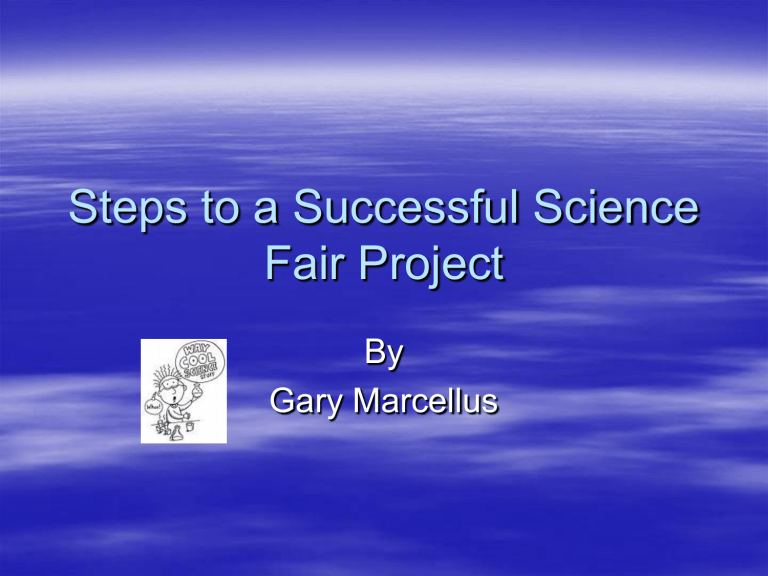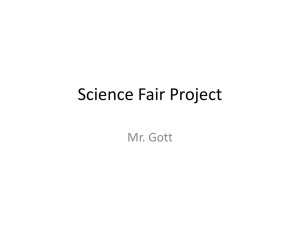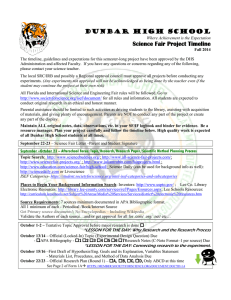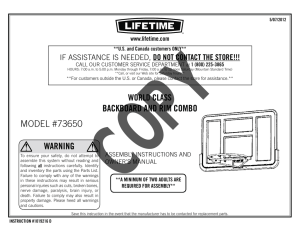Steps to a Successful Science Fair Project (PowerPoint)

Steps to a Successful Science
Fair Project
By
Gary Marcellus
Why Do a Science Fair Project?
Teacher’s perspective
Mandated to teach science content
Need to remember the intent of the Science curriculum
“Children have a natural curiosity about their surroundings —a desire to explore and investigate, see inside things, find out how things work and find answers to their questions.”
Why Do a Science Fair Project?
Student’s perspective
To learn to think scientifically and see what it is like to be a scientist.
To make your own observations about the world.
Provide an opportunity to take the initiative in my learning.
To improve my use of science processes to solve problems.
To become actively involved in learning and participating in science.
To learn how to organize and finish a long-term project.
The Scientific Method
A Science Fair project is an opportunity to investigate some event or phenomena in the same way a scientist would investigate it.
Scientific Method Steps
Hypothesis
Experimenting
Data Collection
Conclusion
Safety (Part 1)
1. Exhibit is no more than 0.8 m deep,
1.2 m wide and 2.4 m high.
2. No chemicals are on display.
3. No open flames are on display.
4. No live animals are on display.
5. Experiments using vertebrates must be supervised by a vet or performed in a qualified lab. An Ethics form must be filled out prior to starting ANY animal research
Safety (Part 2)
6. Electrical power cords have 3-wire grounded connections.
7. Electrical connections are insulated.
8. Non-current carrying metal parts are connected to the ground lead.
9. Lasers will not be operated during public display.
Safety (Part 3)
10. No biological toxins are on display.
11. All microbial cultures are sealed.
12. No organisms pathogenic are on display.
13. Maximum of two students may work on the project.
14. For projects involving humans, check the website: www.wbrsf.ca/forms.html
Levels of Science Fair Projects
Level 1
A diagram, copy, illustration, table or display of science information already available.
Level 2
A chart, illustration, model, collection, specimen, or chart based on first-hand investigation by the student.
Levels of Science Fair Projects
Level 3
A working model based on an understanding of a scientific principle.
Level 4
An attempt to answer a question by designing and conducting an experiment or a correlational model in which one or more variables were tested, but for which circumstances or lack of knowledge prevented adequate control of significant independent variables.
Levels of Science Fair Projects
Level 5
An attempt to answer a question by designing and conducting an experiment or correlation study in which all the important variables are controlled.
Ladder of Success
Logbook
All students need to keep a logbook to record all of their Science Fair project work.
Choosing a Topic
A good topic will:
– Be specific
– Be of interest to you
– Be stated as a question
– Involve experimentation if possible
– Be something you can successfully complete.
Good Topic
For example:
“What are the effects of fertilizers on bean plants?
Develop Your Purpose
Try to explain the purpose of the project in two or three sentences. A possible way of starting is: “The purpose of the project is to .
. .” The purpose may include the hypothesis
For example:
The purpose of the project is to determine if
Brand A fertilizer is better then Brand B in causing bean plants to grow quickly.
Research
Begin your research by using the library, internet or professionals.
Make sure you keep your notes in your logbook.
Use proper bibliographic style.
Gather Your Materials
Make a list of specific materials.
If you need seeds, they could be difficult to find in January or February.
Experimenting
Experiments need to include controls:
– Independent variable—the experimenter changes something to observe what will happen
– Dependent variable—the experimenter changes something to observe what will happen. These changes produce a response that can be measured in some way (i.e. your experimental plants grow higher). This response is the dependant variable.
Experimenting
– Control the variables - in a fertilizer experiment, the experimenter would ensure that the plants grow in the same size container, receive the same amount of light and water, and the same amounts of and type of soil
– (Negative) Control group - in a fertilizer experiment, these are seeds that do not receive any fertilizer
Organize Your Results
Observations of your experiment need to be organized.
A graph is the best way to do this.
Draw Your Conclusions
You have done the experiment, and have collected data. Now you must interpret that data.
The data will either support or disprove your original hypothesis.
Write Your Research Paper
The parts of the research paper
– Title page
– Purpose
– Acknowledgments
– Material and methods
– Conclusion
– Further study and application
– Bibliography
Construct Your Backboard
Your backboard is like an advertisement for your project! It shows your teacher, classmates, and fair judges the hard work you put into your project. You want your backboard to be neat, professional, and interesting.
Parts of a Backboard
Be sure to include all of the following items on your science fair display board:
the title
a purpose statement
your hypothesis
the procedure
data and results - charts, graphs, analysis
your conclusions
Present Your Project
Practice your presentation before presenting to your class or judges.
Everybody who completes a project is a winner!








